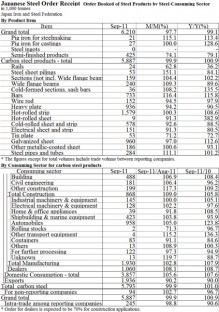Japanese carbon steel order receipt increased by 1.0% to 5.793 million tonnes in September from a year earlier, which increased for 2 months in a row, announced by Japan Iron & Steel Federation on Monday. The domestic orders increased by 23.8% to 958,000 tonnes for automobile while the domestic orders decreased by 6.1% to 423,000 tonnes for shipbuilding due to shipbuilders’ lower order intake. The export orders decreased by 10.0% to 1.936 million tonnes under historically high yen rate.
The orders increased by 7.6% to 3.857 million tonnes for domestic buyers in September from a year earlier, which increased for 2 months in a row. The orders increased by 7.9% to 1.93 million tonnes from manufacturers, which increased for 2 months in a row. The orders from automobile increased from the bottom of 442,000 tonnes in May to 616,000 tonnes in June, 760,000 tonnes in July and 912,000 tonnes in August. The orders increased by 5.1% for industrial machinery from a year earlier while the orders decreased by 6.1% for shipbuilding and by 2.4% for home and office appliances. The orders for construction increased by 5.8% to 868,000 tonnes in September from a year earlier. The building demand recovered for condominium and residential buildings. The civil work demand showed sign for rebuilding activity in damaged areas by the major earthquake when sheet pile order increased by 50% from August. The export orders decreased in September from a year earlier, which was first decrease in 2 months. The orders decreased to less than 2 million tonnes for the first time in 4 months. The carbon steel orders decreased by 3.2% to 33.6 million tonnes in April-September from same period of 2010. The orders decreased by 2.5% to 21.188 million tonnes for domestic market and by 4.4% to 12.413 million tonnes for export. The domestic demand is expected to recover in second half of fiscal 2011 ending March 2012 when automobile production keeps high level and the rebuilding activity gets into full scale. However, the export could decrease due to low Asian steel price, high yen rate and Thai flood.| M | T | W | T | F | S | S |
|---|---|---|---|---|---|---|
| « Sep | ||||||
| 1 | 2 | 3 | 4 | 5 | 6 | |
| 7 | 8 | 9 | 10 | 11 | 12 | 13 |
| 14 | 15 | 16 | 17 | 18 | 19 | 20 |
| 21 | 22 | 23 | 24 | 25 | 26 | 27 |
| 28 | 29 | 30 | ||||
Japan Steel Scrap Composite Prices (Sangyo Press)
2025/04/01| H2 | NewCutting (PRESS) |
| 41000YEN (-) | 43500YEN (-) |
| 275.5US$ (-0.56) | 292.3US$ (-0.59) |
* Average of electric furnaces steel maker's purchasing price in Tokyo, Osaka and Nagoya (per ton)
- JMB Tieup company
- The Korea Metal Journal
- ferro-alloys.com
- Steel on the net
- AMM
- MEPS













